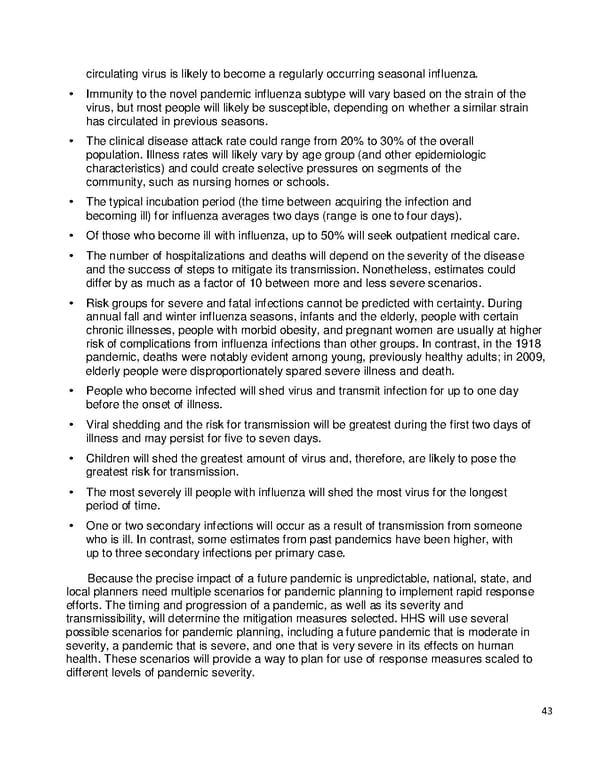circulating virus is likely to become a regularly occurring seasonal influenza. • Immunity to the novel pandemic influenza subtype will vary based on the strain of the virus, but most people will likely be susceptible, depending on whether a similar strain has circulated in previous seasons. • The clinical disease attack rate could range from 20% to 30% of the overall population. Illness rates will likely vary by age group (and other epidemiologic characteristics) and could create selective pressures on segments of the community, such as nursing homes or schools. • The typical incubation period (the time between acquiring the infection and becoming ill) for influenza averages two days (range is one to four days). • Of those who become ill with influenza, up to 50% will seek outpatient medical care. • The number of hospitalizations and deaths will depend on the severity of the disease and the success of steps to mitigate its transmission. Nonetheless, estimates could differ by as much as a factor of 10 between more and less severe scenarios. • Risk groups for severe and fatal infections cannot be predicted with certainty. During annual fall and winter influenza seasons, infants and the elderly, people with certain chronic illnesses, people with morbid obesity, and pregnant women are usually at higher risk of complications from influenza infections than other groups. In contrast, in the 1918 pandemic, deaths were notably evident among young, previously healthy adults; in 2009, elderly people were disproportionately spared severe illness and death. • People who become infected will shed virus and transmit infection for up to one day before the onset of illness. • Viral shedding and the risk for transmission will be greatest during the first two days of illness and may persist for five to seven days. • Children will shed the greatest amount of virus and, therefore, are likely to pose the greatest risk for transmission. • The most severely ill people with influenza will shed the most virus for the longest period of time. • One or two secondary infections will occur as a result of transmission from someone who is ill. In contrast, some estimates from past pandemics have been higher, with up to three secondary infections per primary case. Because the precise impact of a future pandemic is unpredictable, national, state, and local planners need multiple scenarios for pandemic planning to implement rapid response efforts. The timing and progression of a pandemic, as well as its severity and transmissibility, will determine the mitigation measures selected. HHS will use several possible scenarios for pandemic planning, including a future pandemic that is moderate in severity, a pandemic that is severe, and one that is very severe in its effects on human nse measure health. These scenarios will provide a way to plan for use of respo s scaled to different levels of pandemic severity. 43
 Pandemic Influenza Plan Page 42 Page 44
Pandemic Influenza Plan Page 42 Page 44